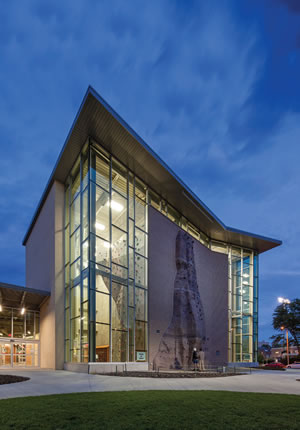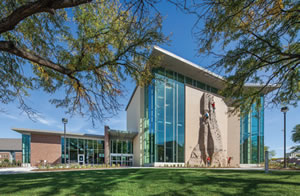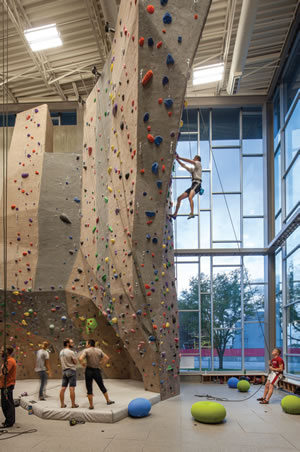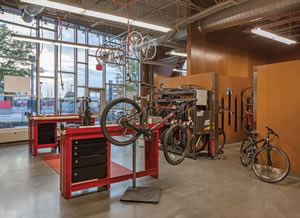Great Heights
- By Al Oberlander, Jordan Messerer
- 11/01/16

PHOTOS © TOM KESSLER, KESSLER PHOTOGRAPHY, COURTESY OF RDG PLANNING & DESIGN
The surge in environmental awareness at colleges and universities nationwide corresponds with increased interest
in outdoor adventures programs. On the whole, though, outdoor programs exist in found space on most campuses, and
not much of it — 3,000 square feet tucked into the lower level of the recreation center, perhaps, with lack of visibility and
storage being ongoing issues. A few institutions have gotten creative — the University of Maine, for example, installed
the Maine Bound Adventure Center inside a renovated barn located behind the Memorial Union — but these are generally
facilities that don’t keep students in the building after the forms are signed and the equipment is issued.
How the University of Nebraska-Lincoln
became the home of an apparent national
first — the Outdoor Adventures Center
(OAC), a standalone facility dedicated to the
school’s outdoor program that includes activity
space as part of its 13,532 square feet —
was partly due to the school’s longstanding
devotion to outdoor activities, and partly
a consequence of a three-part student-fee
referendum that made the program the odd
man out in a renovation of the school’s 1989
recreation center. But its existence, and the
measurable impact it made on Nebraska in
just its first year, suggests that dedicated
outdoor adventures centers could be in a few
schools’ futures in the years ahead.
Standing Tall
One particular feature makes the OAC
stand out on the Nebraska campus in a big
way — a climbing wall on the building’s
exterior that rises to a height of 41 feet. A
permanent belay bar on the roofline can
accommodate three belay lines that for a
fee can be used during special events such
as home football weekends. Designed to
resemble the upper third of the Chimney
Rock National Historic Site (a western Nebraska
landmark that greeted pioneers on
their way west along the Oregon Trail), the
exterior wall is controlled by the removal of
handholds and footholds between 10 and 20 feet off the ground, keeping the lower
portion available for bouldering at all
times. The wall is a destination spot,
a “happening,” but it also telegraphs
the building’s purpose, drawing
attention to the rest of the outdoors
program.

PHOTOS © TOM KESSLER, KESSLER PHOTOGRAPHY, COURTESY OF RDG PLANNING & DESIGN
And there’s more inside. The
climbing and bouldering center
features a bouldering wall and four
climbing walls ranging from 38 to
43 feet in vertical climbing height
interspersed with floor-to-ceiling
windows, which brings a canyon
feel to the space that is nonetheless
light and airy. The climbing center
comprises 3,200 square feet of floor
space, and the walls have been fabricated
primarily for skill development
and training for competitions. The
recreation department insisted on
the inclusion of four cracks to enable
the teaching of crack climbing in a
controlled setting.
The OAC also houses the campus
bike shop (reached from the outside
through double sliding glass doors
on the west entrance) and a dividable
classroom that doubles as a conference
room/meeting space for the
staff, which enjoys direct egress to an
exterior patio area to the south of the
facility where tent set-up, camp stove
training or other outdoor adventures
learning experiences can take place.
A storage/workroom includes a
food service area where, to cite one
example, 1,050 meals were prepared
for students taking backpacking,
canyoneering, surfing and canoeing
trips over spring break in 2015. The
classroom, as well as day-use lockers
and three locker rooms, can be
accessed without the entire building
being open for operation. In fact, all
primary indoor spaces can be operated
independently.
The building’s layout — professional
staff offices are located
centrally, with storefront glass walls
making it possible for the staff to
observe all daily operations — allows
for easy access to each activity area
independently and the free movement
between all areas. Additional
storage space can be found in the
volume behind the climbing walls.
Outside, to the east, a fenced exterior
courtyard and canopy accommodates
canoes, kayaks and trip trailers. The
fence is secured with a gate and staff
have secure access into the OAC storage/workroom of the facility via an
overhead garage door.
These details lend the building
something close to the experience
of a full-fledged recreation center,
if at a smaller scale. With its profile
designed to resemble the peaks and
undulations of a mountain, and lit to
glow from within like a beacon, the
climbing center portion is a showcase
for activity and a potent symbol of the
institution’s commitment to the outdoor
program. And it’s more than just
a space to rent and pick up gear —
it’s a facility where learning takes
place in addition to recreation.

PHOTOS © TOM KESSLER, KESSLER PHOTOGRAPHY, COURTESY OF RDG PLANNING & DESIGN
LEARNING BEYOND THE WALLS.
For the University of Nebraska –
Lincoln, building the Outdoor
Adventures Center (OAC) was
part of an overall student
referendum to add, improve and
enhance the current recreation
facilities on campus. The
OAC is the headquarters for
adventure trips, academic and
noncredit classes and activities,
challenge course programming,
outdoor gear rentals and the
campus bike shop. There is an
exterior patio area to the south
that allows those teaching a
class to move straight into the
outdoors for various outdoor
adventures’ learning experiences.
The completion of the OAC
has allowed the university’s
Outdoor Adventures program
to grow exponentially since the
facility opened in May 2014.
Climbing Higher
The OAC has been so successful
and promoted so much activity
and excitement on campus that it’s
almost difficult to remember how
close it came to not being built at all.
The university has been a proponent
of outdoor programs for more than
50 years — Nebraska’s program
was founded in 1972, and the school
actually built a rudimentary outdoor
climbing wall on the back of a tennis
court backstop in 1976 — but
the circumstances had to arrange
themselves in a way that made such a
building feasible, and necessary.
Nebraska’s outdoor adventures
program moved into the brand-new
Campus Recreation Center in 1989,
but space for certain elements associated
with the program were limited
and difficult to expand as demand
increased — for example, the climbing
wall, which was built alongside
a gymnasium court. Fitness space
was also proving difficult to expand,
and there was a certain rationale to removing the outdoor adventures program from the equation so
that cardiovascular and strength areas could take over its space.
As plans developed for a new East Campus recreation and wellness
center to be created through the renovation and expansion of the
existing 1926 Activities Building, the prevailing current was toward
relocating the outdoor adventures program there. This sent a chill
through administrators of the outdoor adventures program, who
feared being banished from the 18,000-student City Campus in favor
of the 3,000-student East Campus. An ad hoc wellness committee was
formed to discuss ways of keeping the program on the main campus,
and many different options were discussed, including a partnership
with the city of Lincoln to combine outdoor recreation efforts.
Eventually, in 2010, students passed a three-part “Yes 2 Better
Rec Centers” referendum, appropriating student fees to build the
$14.89 million Recreation and Wellness Center on East Campus
and the $5.28 million Outdoor Adventures Center on the City Campus,
and renovate and expand cardiovascular and strength areas
within the Campus Rec Center.
The OAC is an embodiment of a coming change in recreation
as Millennials and teens embrace adventure sports and environmental
causes. The logic that once placed climbing walls at
the front or center of new recreation centers — as much as an
architectural element as an activity space — appears to be giving
way to something more holistic, with indoor climbing walls tied to
the outdoor activities that originally gave birth to them. And there
are, perhaps, other activities that fit better under this umbrella.
For example, the rise of bicycle culture on campuses and in cities
practically cries out for an expansion of the infrastructure devoted
to bicycles — maintaining them, parking them, storing them
indoors — and to the campus fabric that accommodates them.
The OAC is a step in this direction, with a generous space devoted
to bike maintenance, 22 bicycle lockers available for rent (to members
of the university community using the OAC and other nearby
buildings), and a location along one link in the Lincoln community’s
extensive trail system.

PHOTOS © TOM KESSLER, KESSLER PHOTOGRAPHY, COURTESY OF RDG PLANNING & DESIGN
A major focus of the building is to promote bike commuting to
campus, as befits the broader efforts of both the university and the
OAC’s designers. The university has been recognized as “Bicycle
Friendly University: Silver” by the League of American Bicyclists,
and the OAC helps move the university’s “BikeUNL” initiative
forward. More than altruism is at work. If students can be moved
away from bringing cars on campus, the university achieves potential
savings in the infrastructure devoted to automobiles.
RDG Planning & Design, meanwhile, has worked with the
Des Moines Bike Collective back at home (“Changing Greater Des
Moines two wheels at a time”) to promote downtown bicycle lanes
and regional trails, as well as with the Green Streets Initiative, a
Cambridge, MA-based organization dedicated to helping individuals
and businesses change their mindset about transportation in
their communities.
Additional facilities like the OAC will pop up as more people
join these efforts, but also, just because the OAC exists. The college
recreation center building boom happened because students
demanded them and because the new centers became important
recruiting tools. For now, UNL enjoys a huge edge among
adventurous, active and environmentally conscious prospective
students, but it’s unlikely to last long.
This article originally appeared in the issue of .